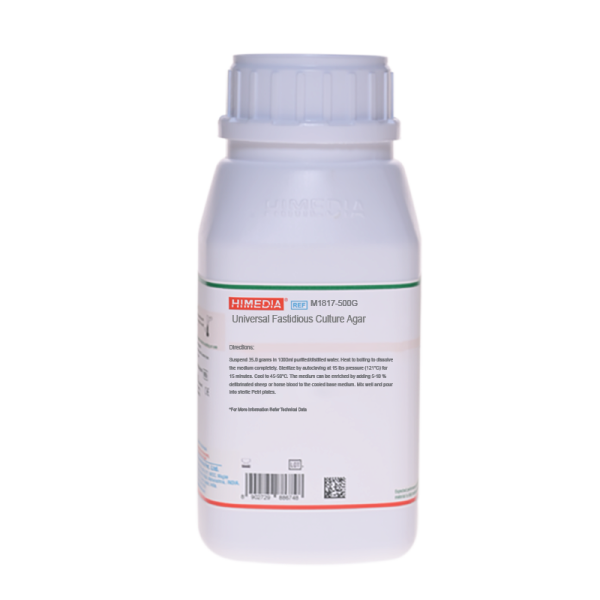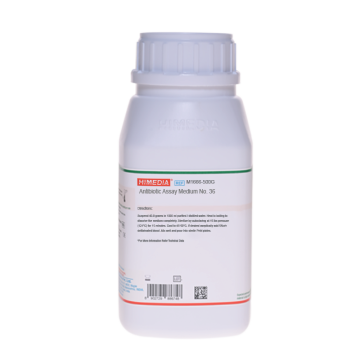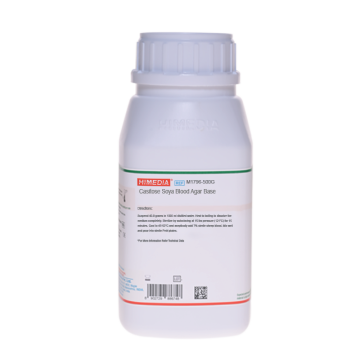 Your enquiry has been submitted
Your enquiry has been submitted
Universal Fastidious Culture Agar
Intended Use
For the cultivation of fastidious microorganisms when enriched with blood.
Composition
| Ingredients | g / L |
|---|---|
| HM peptone# | 5.000 |
| Gelatin peptone | 5.000 |
| Casitose ▲ | 3.500 |
| Tryptone | 3.500 |
| Yeast extract | 3.000 |
| Sodium chloride | 5.000 |
| Agar | 10.000 |
**Formula adjusted, standardized to suit performance parameters
▲ - Equivalent to Casein Peptone, # - Equivalent to Meat Peptone
Directions
Suspend 35 grams in 1000ml purified / distilled water. Heat to boiling to dissolve the medium completely. Sterilize by autoclaving at 15 lbs pressure (121°C) for 15 minutes. Cool to 45-50°C. The medium can be enriched by adding 5-10 % defibrinated sheep or horse blood to the cooled base medium. Mix well and pour into sterile Petri plates.
Principle And Interpretation
Universal Fastidious Culture Agar is a basic culture media for cultivation of fastidious organisms by enriching the basal medium with blood. It is non-selective media useful in routine cultivation of microorganisms. It can be used for the cultivation and enumeration of bacteria which are not particularly fastidious. Addition of different biological fluids such as horse or sheep blood, serum, egg yolk etc. makes it suitable for the cultivation of related fastidious organisms. HM peptone, gelatin peptone, tryptone, casitose and yeast extract provide the necessary nitrogen , carbon compounds, long chain amino acids, vitamins and also some trace ingredients necessary for the growth of bacteria. Sodium chloride maintains the osmotic equilibrium of the medium.
Type of specimen
Clinical samples- Skin lesions, Throat swab; Food & dairy samples; Water samples; soil samples.
Specimen Collection and Handling
For Clinical samples, follow appropriate techniques for sample collection and processing as per guidelines (1,2).
For Food & dairy samples, follow appropriate techniques for sample collection, processing as per guidelines (3,4,5).
For water samples, follow appropriate techniques for sample collection, processing as per guidelines and local standards (6).
For soil samples, follow appropriate techniques for sample collection and processing as per guidelines (1).
After use, contaminated materials must be sterilized by autoclaving before discarding.
Warning and Precautions
In Vitro diagnostic Use. For professional use only. Read the label before opening the container. Wear protective gloves/ protective clothing/eye protection/ face protection. Follow good microbiological lab practices while handling specimens and culture. Standard precautions as per established guidelines should be followed while handling clinical specimens. Safety guidelines may be referred in individual safety data sheets.
Limitations
- It is not recommended for the recovery of acutely fastidious organisms such as Helicobacter pylori, Legionella pneumophila or Bartonella (Rochalimaea) henselae.
- Further biochemical and serological tests must be carried out for complete identification.
Performance and Evaluation
Performance of the medium is expected when used as per the direction on the label within the expiry period when stored at recommended temperature.
Quality Control
Appearance: Cream to yellow homogeneous free flowing powder
Gelling: Firm, comparable with 1.5% Agar gel
Colour and Clarity of prepared medium: Basal Medium : Light yellow coloured clear to slightly opalescent gel. After addition of 5-7%w/v sterile defibrinated blood : Cherry red coloured opaque gel forms in Petri plates
Cultural response: Cultural characteristics was observed after an incubation at 30-35°C 18-24 hours.
| Organism | Inoculum (CFU) | Growth | Recovery | Growth w/ blood | Recovery w/ blood | Haemolysis |
|---|---|---|---|---|---|---|
| Streptococcus pyogenes ATCC 19615 | 50 -100 | luxuriant | >=70 % | luxuriant | >=70 % | |
| Staphylococcus aureus subsp. aureus ATCC 25923 (00034*) | 50 -100 | luxuriant | >=70 % | luxuriant | >=70% | beta |
| Enterococcus durans ATCC 10541 | 50 -100 | luxuriant | >=70 % | luxuriant | >=70 % | alpha |
| Enterococcus faecalis ATCC 29212 (00087*) | 50 -100 | luxuriant | >=70 % | luxuriant | >=70 % | none |
| Salmonella Typhimurium ATCC 13311 (00121*) | 50 -100 | luxuriant | >=70 % | luxuriant | >=70 % | |
| Shigella flexneri ATCC 12022 (00126*) | 50 -100 | luxuriant | >=70 % | luxuriant | >=70% | none |
Key : (*) Corresponding WDCM numbers.
Storage and Shelf Life
Store below 10-30°C in a tightly closed container and the prepared medium at 2-8°C. Use before expiry date on the label. On opening, product should be properly stored dry, after tightly capping the bottle in order to prevent lump formation due to the hygroscopic nature of the product. Improper storage of the product may lead to lump formation. Store in dry ventilated area protected from extremes of temperature and sources of ignition. Seal the container tightly after use. Product performance is best if used within stated expiry period.
Disposal
User must ensure safe disposal by autoclaving and/or incineration of used or unusable preparations of this product. Follow established laboratory procedures in disposing of infectious materials and material that comes into contact with clinical sample must be decontaminated and disposed of in accordance with current laboratory techniques (3,4).
Reference
- Isenberg, H.D. Clinical Microbiology Procedures Handbook 2nd Edition.
- Jorgensen, J.H., Pfaller, M.A., Carroll, K.C., Funke, G., Landry, M.L., Richter, S.S and Warnock., D.W. (2015) Manual of Clinical Microbiology, 11th Edition. Vol. 1.
- American Public Health Association, Standard Methods for the Examination of Dairy Products, 1978, 14th Ed., Washington D.C.
- Wehr H. M. and Frank J. H., 2004, Standard Methods for the Microbiological Examination of Dairy Products, 17th Ed., APHA Inc., Washington, D.C.
- Salfinger Y., and Tortorello M.L. Fifth (Ed.), 2015, Compendium of Methods for the Microbiological Examination of Foods, 5th Ed., American Public Health Association, Washington, D.C.
- Lipps WC, Braun-Howland EB, Baxter TE,eds. Standard methods for the Examination of Water and Wastewater, 24th ed. Washington DC:APHA Press; 2023.
- Subba Rao N. S., 1977, Soil Microorganisms and Plant Growth, Oxford and IBH Publishing Co., New Delhi.
| Product Name | Universal Fastidious Culture Agar |
|---|---|
| SKU | M1817 |
| Product Type | Regular |
| Physical Form | Powder |
| Origin | Animal |
| Packaging type | HDPE |
| References | 1. American Public Health Association, Standard Methods for the Examination of Dairy Products, 1978, 14th Ed., Washington D.C. 2. Baird R.B., Eaton A.D., and Rice E.W., (Eds.), 2015, Standard Methods for the Examination of Water and Wastewater, 23rd ed., APHA, Washington, D.C. 3. Isenberg, H.D. Clinical Microbiology Procedures Handbook 2nd Edition 4. Jorgensen, J.H., Pfaller, M.A., Carroll, K.C., Funke, G., Landry, M.L., Richter, S.S and Warnock., D.W. (2015) Manual of Clinical Microbiology, 11th Edition. Vol. 1. 5. Salfinger Y., and Tortorello M.L. Fifth (Ed.), 2015, Compendium of Methods for the Microbiological Examination of Foods, 5th Ed., American Public Health Association, Washington, D.C. 6. Subba Rao N. S., 1977, Soil Microorganisms and Plant Growth, Oxford and IBH Publishing Co., New Delhi. 7. Wehr H. M. and Frank J. H., 2004, Standard Methods for the Microbiological Examination of Dairy Products, 17th Ed., APHA Inc., Washington, D.C. |
| Customized Product Available | No |








